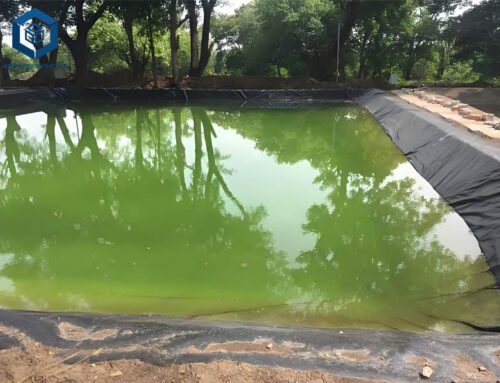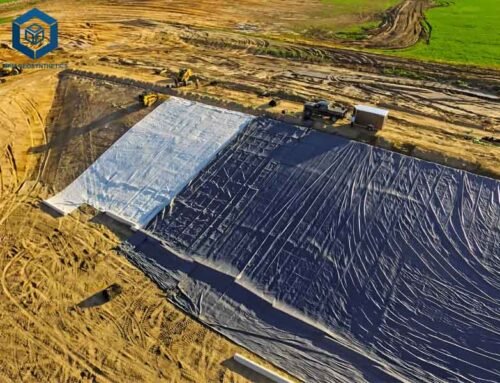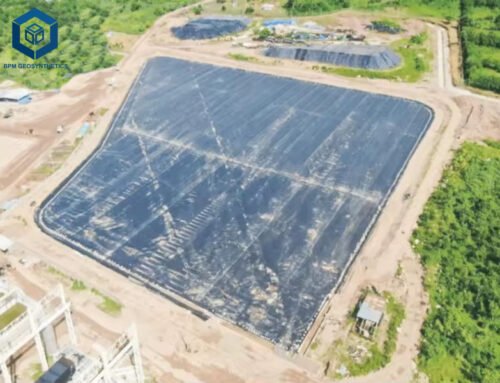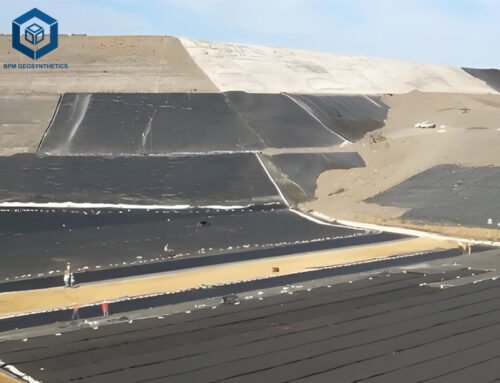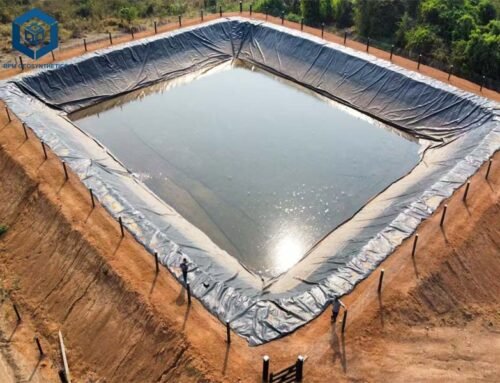High Density Polyethylene Pond Liner as know as HDPE pond liner is a synthetic geotechnical material made of high-density polyethylene (HDPE). It is a flexible film with good anti-seepage performance and chemical stability. It is widely used in various projects to prevent the penetration of water, chemicals or gases, while isolating and protecting the soil.
The manufacturing process of BPM HDPE Geomembrane usually involves polymer chemical process, which is melt extruded from high-density polyethylene particles to prepare film. The film has a certain thickness range, generally between 0.5mm~3.0mm, and the appropriate thickness can be selected according to specific project requirements.
1. What Is High Density Polyethylene Pond Liner?
High Density Polyethylene (HDPE) pond liner is a type of synthetic membrane made specifically for water containment applications such as ponds, pools, reservoirs, and similar bodies of water. It is known for its strength, durability, and longevity, making it suitable for long-term use. The material is impermeable to water, preventing leakage and maintaining the water level in the pond. HDPE liners are also chemical resistant, UV resistant, and puncture-resistant. They can be installed in various terrains and shapes due to their flexibility and can be joined by heat-welding the seams to create a watertight barrier. Compared to other materials, HDPE offers cost savings because of its long lifespan and minimal maintenance requirements. Proper installation techniques are crucial to avoid damages such as punctures or tears during installation. HDPE liner helps prevent contaminants in the soil from leaching into the water body and vice versa, protecting both the ecosystem and humans.
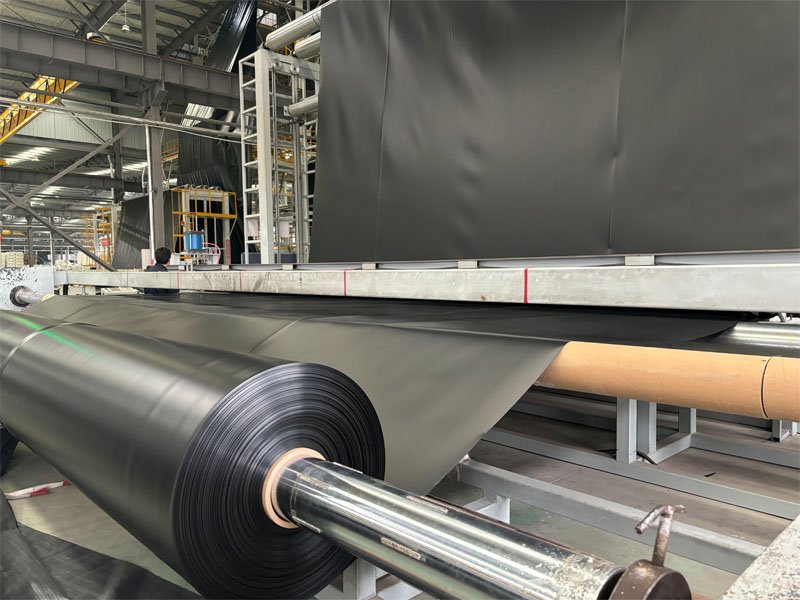
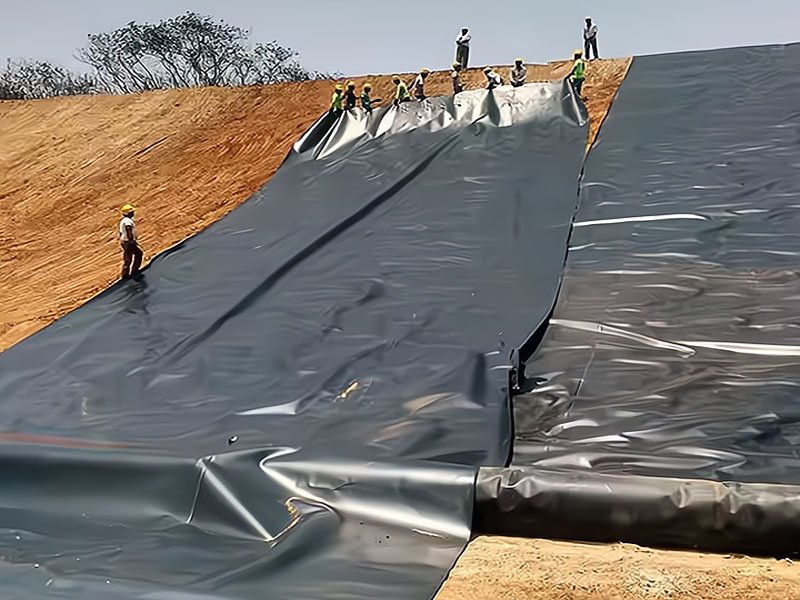
2.What Are Characteristics Of High Density Polyethylene Pond Liner?
High Density Polyethylene (HDPE) pond liner is a type of synthetic membrane made from high-density polyethylene material. It is specifically designed for use in water containment applications such as ponds, pools, water reservoirs, and similar bodies of water. Here are some key characteristics of HDPE Pond Liner:
2.1 Durability and Longevity:
- Strength and Resistance: HDPE liners are known for their exceptional strength and durability, making them suitable for long-term use. They can withstand harsh weather conditions and UV exposure without degrading.
- Chemical Stability: The material does not react with chemicals in the water, ensuring that water quality is not affected.
2.2 Impermeability:
- Waterproof Barrier: HDPE is impermeable to water, preventing leakage and maintaining the water level in the pond.
- Preventing Contamination: HDPE helps prevent pollutants in the soil from leaching into water bodies, protecting ecosystems and people.
2.3 Puncture Resistance:
- Physical Protection: While HDPE is relatively puncture-resistant, it is still possible to damage it, especially during installation. Proper installation techniques are crucial to avoid damages.
2.4 UV Resistance:
- UV Protection: Some HDPE liners come with UV protection on one side, which is important for above-ground applications or when the liner may be exposed to sunlight.
2.5 Installation Versatility:
- Flexibility and Conformity: HDPE liners can be installed in various terrains and shapes due to their flexibility. They can conform to irregular surfaces and can be joined by heat-welding the seams to create a watertight barrier.
2.6 Cost-Effective:
- Economic Advantages: Compared to other materials, HDPE offers cost savings because of its long lifespan and minimal maintenance requirements.
2.7 Environmental Benefits:
- Ecosystem Protection: HDPE liners can effectively prevent pollutants from seeping into water bodies, thus protecting the environment from pollution.
- Sustainability: HDPE is a recyclable material, which means old or discarded liners can be recycled into new products.
3. What Scenarios Are High Density Polyethylene Pond Liner Suitable For?
- Freshwater and Saltwater Ponds: Lining both freshwater and saltwater ponds to prevent leakage and soil contamination.
- Water Management: In agricultural and recreational settings, managing water resources effectively by containing irrigation water or creating decorative features.
- Wastewater Treatment: In wastewater treatment ponds and lagoons, where the liner prevents contamination of the soil and groundwater.
- Aquaculture: For fish farms and aquaculture ponds, where the liner helps maintain water quality.
- Water Storage: Lining reservoirs and tanks to store potable water.
- Ecosystem Protection: Separating harmful substances from natural environments to protect local flora and fauna.
4. How To Choose Right High Density Polyethylene Pond Liner?
Choosing the right High Density Polyethylene (HDPE) pond liner is crucial for the success and longevity of your water containment project. Here’s a step-by-step guide to help you select the appropriate HDPE liner:
4.1 Determine Your Needs:
- Purpose: What will the pond be used for (e.g., decorative, ecological, aquaculture, etc.)?
- Size: Measure the dimensions and calculate the surface area to determine how much liner you’ll need.
- Depth: Consider the depth to ensure the liner can withstand the water pressure.
4.2 Material Thickness:
- Choose a thickness that can handle the expected water pressure and usage. Typical thicknesses range from 0.3mm to 2mm.
4.3 Durability:
- Look for liners with high UV resistance if the pond will be exposed to sunlight.
- Consider additional protection like an EPDM (Ethylene Propylene Diene Monomer) or PVC (Polyvinyl Chloride) cover for increased durability.
4.4 Seam Strength:
- Ensure the seams are heat-welded for maximum strength and waterproofing.
4.5 Certifications:
- Check for certifications such as NSF/ANSI Standard 61, which ensures the material is safe for contact with drinking water.
4.6 Manufacturer Reputation:
- Purchase from a reputable manufacturer with a proven track record of quality and customer service.
4.7 Cost:
- Compare prices from different suppliers, but don’t compromise on quality for cost savings.
4.8 Installation:
- Consider the installation process and whether you have the necessary equipment and expertise. Some manufacturers offer installation services.
4.9 Warranty:
- Check the warranty period and coverage to protect your investment.
4.10 Local Regulations:
- Ensure the liner complies with local regulations and requirements for water containment systems.

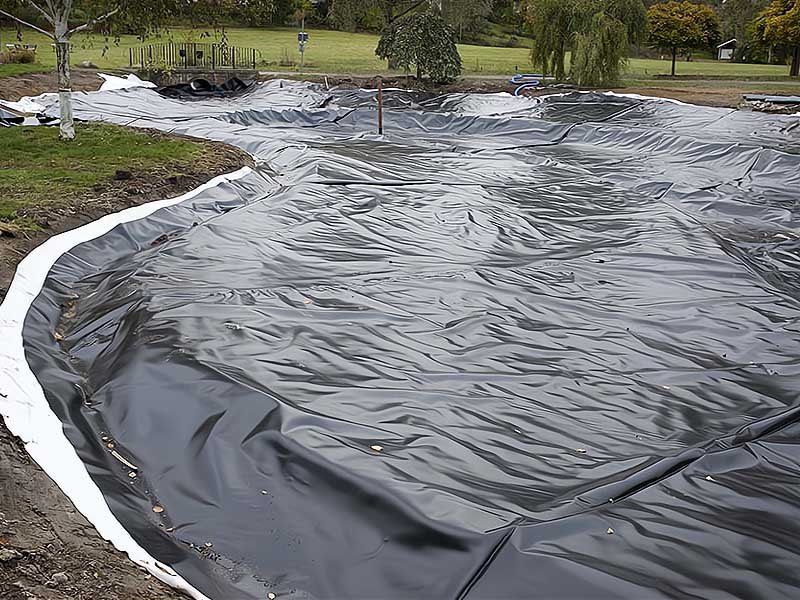
5. How to Install And Maintain High Density Polyethylene Pond Liner?
5.1 Install
To install an HDPE pond liner, begin by clearing the sharp objects and grading the soil for proper drainage. Lay a protective base of sand or soil, ensuring it’s smooth and compacted. Carefully unroll the liner to avoid wrinkles, and cut it to fit the pond with extra space for seams. Heat-weld or use adhesive to join the liner pieces, creating waterproof seams. Fill the pond gradually, monitoring for leaks and allowing the liner to settle.
5.2 Maintain
Maintain the liner by regularly removing debris and algae with a soft brush, avoiding harsh chemicals. Inspect the liner periodically for damage or wear, especially at the seams and edges. Promptly repair any damages using patch kits or re-welding as needed. In cold climates, consider winterizing measures like partial draining or using de-icers to prevent freezing damage. Follow these steps to keep your HDPE pond liner in optimal condition for long-lasting water containment.
6. Summary
To choose the right High Density Polyethylene (HDPE) pond liner, consider the pond’s purpose, size, and depth. Select a liner thickness that can withstand the water pressure and UV exposure. Look for durable materials, heat-welded seams, and certifications. Purchase from a reputable manufacturer and ensure the liner complies with local regulations. Evaluate installation requirements and warranties to protect your investment.
If you have any further questions, please feel free to contact us.

